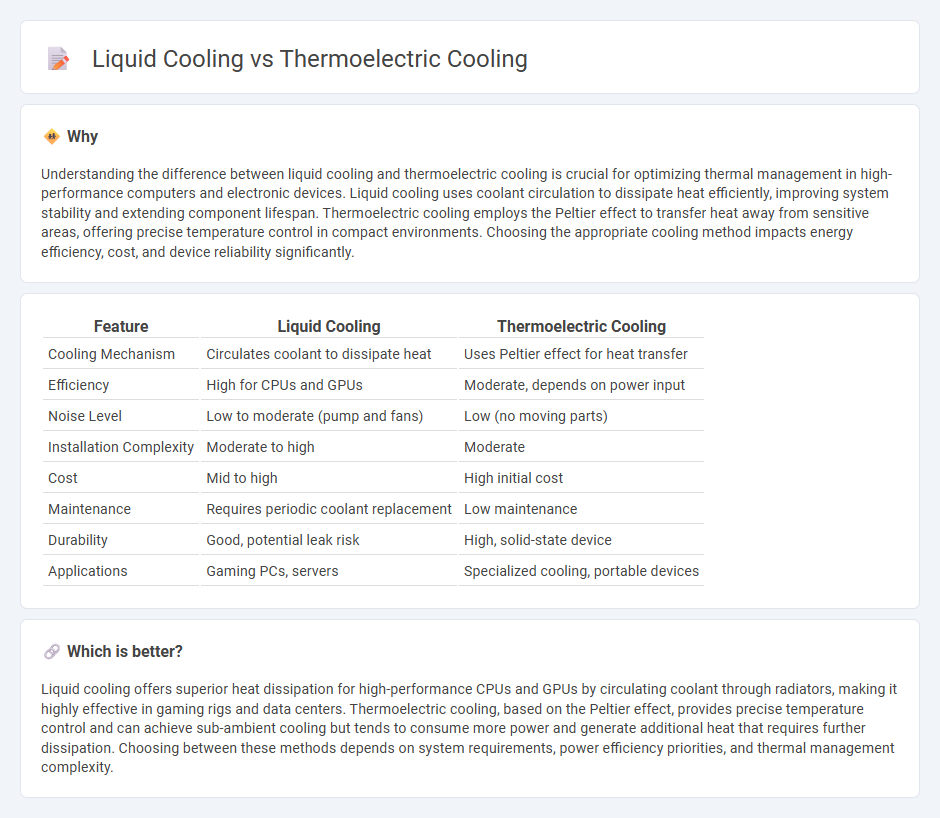
Liquid cooling utilizes a circulation system that transfers heat efficiently from components like CPUs and GPUs, making it ideal for high-performance computing and gaming setups. Thermoelectric cooling employs the Peltier effect to create a temperature difference by transferring heat from one side of a semiconductor to the other, enabling compact and precise cooling solutions. Explore the advantages and applications of liquid and thermoelectric cooling technologies to determine the best fit for your cooling needs.
Why it is important
Understanding the difference between liquid cooling and thermoelectric cooling is crucial for optimizing thermal management in high-performance computers and electronic devices. Liquid cooling uses coolant circulation to dissipate heat efficiently, improving system stability and extending component lifespan. Thermoelectric cooling employs the Peltier effect to transfer heat away from sensitive areas, offering precise temperature control in compact environments. Choosing the appropriate cooling method impacts energy efficiency, cost, and device reliability significantly.
Comparison Table
| Feature | Liquid Cooling | Thermoelectric Cooling |
|---|---|---|
| Cooling Mechanism | Circulates coolant to dissipate heat | Uses Peltier effect for heat transfer |
| Efficiency | High for CPUs and GPUs | Moderate, depends on power input |
| Noise Level | Low to moderate (pump and fans) | Low (no moving parts) |
| Installation Complexity | Moderate to high | Moderate |
| Cost | Mid to high | High initial cost |
| Maintenance | Requires periodic coolant replacement | Low maintenance |
| Durability | Good, potential leak risk | High, solid-state device |
| Applications | Gaming PCs, servers | Specialized cooling, portable devices |
Which is better?
Liquid cooling offers superior heat dissipation for high-performance CPUs and GPUs by circulating coolant through radiators, making it highly effective in gaming rigs and data centers. Thermoelectric cooling, based on the Peltier effect, provides precise temperature control and can achieve sub-ambient cooling but tends to consume more power and generate additional heat that requires further dissipation. Choosing between these methods depends on system requirements, power efficiency priorities, and thermal management complexity.
Connection
Liquid cooling and thermoelectric cooling both enhance thermal management in high-performance electronics by efficiently dissipating heat to maintain optimal operating temperatures. Liquid cooling uses circulating fluids to transfer heat away from components, while thermoelectric cooling employs the Peltier effect to create a temperature differential for heat absorption and rejection. Integrating these systems can improve cooling efficiency, reduce thermal resistance, and extend device lifespan in data centers and advanced computing environments.
Key Terms
Peltier Effect
Thermoelectric cooling relies on the Peltier Effect, where an electric current creates a temperature difference across semiconductor materials, enabling solid-state heat transfer without moving parts. Liquid cooling uses a fluid circulation system to absorb and dissipate heat efficiently, often providing higher thermal conductivity than thermoelectric modules. Explore detailed comparisons of thermoelectric and liquid cooling technologies to understand which suits your specific thermal management needs.
Heat Exchanger
Thermoelectric cooling uses the Peltier effect to transfer heat through a semiconductor heat exchanger, providing precise temperature control with no moving parts but limited cooling capacity. Liquid cooling employs a heat exchanger consisting of a radiator, pump, and coolant to efficiently dissipate heat from components, offering superior thermal performance for high-power applications. Explore the detailed mechanisms and efficiency comparisons of heat exchangers in thermoelectric and liquid cooling systems to optimize your thermal management strategy.
Thermal Conductivity
Thermoelectric cooling relies on the Peltier effect to transfer heat, offering precise temperature control but generally lower thermal conductivity compared to liquid cooling systems. Liquid cooling utilizes fluids with high thermal conductivity to efficiently absorb and dissipate heat from components, making it highly effective for managing high thermal loads. Explore the advantages and specific applications of both cooling technologies to determine the best fit for your thermal management needs.
Source and External Links
Thermoelectric Coolers - Thermoelectric coolers use electricity flowing through two different conductors to create a cooling effect, with one side becoming cold and the other hot, and operate without liquid refrigerants by transferring heat through solid materials.
Thermoelectric Coolers Introduction - the Basics - Thermoelectric coolers (Peltier modules) produce a temperature difference between their two sides, and their performance depends on the geometry and arrangement of thermoelectric pellets, with higher cooling capacity linked to greater power consumption.
Thermoelectric heat pump - Thermoelectric (Peltier) cooling devices use electrical current to move heat from one side of the device to the other, enabling solid-state heating or cooling, and are mainly used for small-scale cooling due to efficiency and cost limitations.
 dowidth.com
dowidth.com